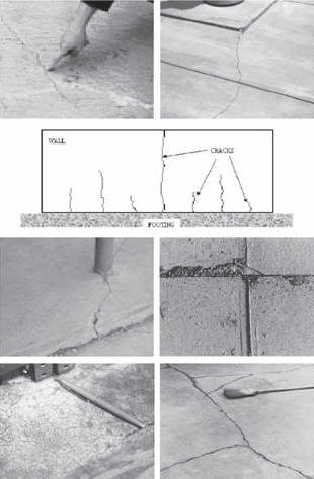Information from the National Ready Mixed Concrete Association
WHAT are Some Forms of Cracks?
 Concrete, like other construction materials, contracts and expands with changes in moisture and temperature, and deflects depending on load and support conditions. Cracks can occur when provisions to accommodate these movements are not made in design and construction. Some common forms of cracks (from top left to bottom right) are:
Concrete, like other construction materials, contracts and expands with changes in moisture and temperature, and deflects depending on load and support conditions. Cracks can occur when provisions to accommodate these movements are not made in design and construction. Some common forms of cracks (from top left to bottom right) are:
- Plastic shrinkage cracks
- Cracks due to improper jointing
- Cracks due to continuous external restraint (example: Cast-in-place wall restrained along botoom edge of footing
- Cracks due to lack of an isolation joint
- D-Cracks from freezing and thawing
- Craze Cracks
- Settlement Cracks
Most random cracks that appear at an early age, although unsightly, rarely affect the structural integrity or the service life of concrete. Closely-spaced pattern cracks or D-cracks due to freezing and thawing, that typically appear at later ages, are an exception and may lead to ultimate deterioration.
WHY Do Concrete Surfaces Crack?
The majority of concrete cracks occur due to improper design and construction practices, such as:
- Omission of isolation and contraction joints and improper jointing practices
- Improper subgrade preparation
- The use of high-slump concrete or the excessive addition of water on the job
- Improper finishing
- Inadequate or no curing
HOW Can Cracking Be Prevented or Minimized?
All concrete has a tendency to crack, and it is not possible to produce completely crack-free concrete. However, cracking can be reduced and controlled if the following basic concreting practices are observed:
- Subgrade and Framework: All topsoil and soft spots should be removed. The soil beneath the slab should be compacted soil or granular fill, well compacted by rolling, vibrating or tamping. The slab, and therefore the subgrade, should be sloped for proper drainage. In winter, remove snow and ice prior to placing concrete and do not place concrete on a frozen subgrade. Smooth, level subgrades help prevent cracking. All formwork must be constructed and braced so that it can withstand the pressure of the concrete without movement. Vapor retarders directly under a concrete slab increase bleeding and greatly increase the potential for cracking, especially with high- slump concrete. When a vapor retarder is used, cover it with 3 to 4 inches of a compactable granular fill, such as a crusher-run material to reduce bleeding. Immediately prior to concrete placement, lightly dampen the subgrade, formwork, and the reinforcement if severe drying conditions exist.
- Concrete: Concrete. In general, use concrete with a moderate slump (not over 5 inches [125 mm]). Avoid re-tempering concrete to increase slump prior to placement. Higher slump (up to 6 or 7 inches [150 to 175 mm]) can be used provided the mixture is designed to produce the required strength without excessive bleeding and/or segregation. This is generally accomplished by using water-reducing admixtures. Specify air-entrained concrete for outdoor slabs subjected to freezing weather.
- Finishing: Initial screeding must be promptly followed by bull floating. DO NOT perform finishing operations with water present on the surface or before the concrete has completed bleeding. Do not overwork or over-finish the surface. For better traction on exterior surfaces, use a broom finish. When ambient conditions are conducive to a high evaporation rate, use means to avoid rapid drying and associated plastic shrinkage cracking by using wind breaks, fog sprays, and covering the concrete with wet burlap or polyethylene sheets between finishing operations.
- Curing: Curing is an important step to ensure durable crack-resistant concrete. Start curing as soon as possible. Spray the surface with liquid membrane curing compound or cover it with damp burlap and keep it moist for at least 3 days. A second application of curing compound the next day is a good quality assurance step.
Follow These Rules to Minimize Cracking
- Design the members to handle all anticipated loads.
- Provide proper contraction and isolation joints.
- In slab on grade work, prepare a stable subgrade.
- Place and finish according to recommended and established practices.
- Protect and cure the concrete properly.
References
- Control of Cracking in Concrete Structures, ACI 224R, American Concrete Institute, Farmington Hills, MI.
- Guide for Concrete Floor and Slab Construction,ACI 302.1R, American Concrete Institute, Farmington Hills, MI.
- Concrete Slab Surface Defects: Causes, Prevention, Repair,IS 177, Portland Cement Association, Skokie, IL.
- Grant T. Halvorson Troubleshooting Concrete Cracking During Construction, Concrete Construction, October 1993.
USED WITH PERMISSION FROM THE NRMCA
